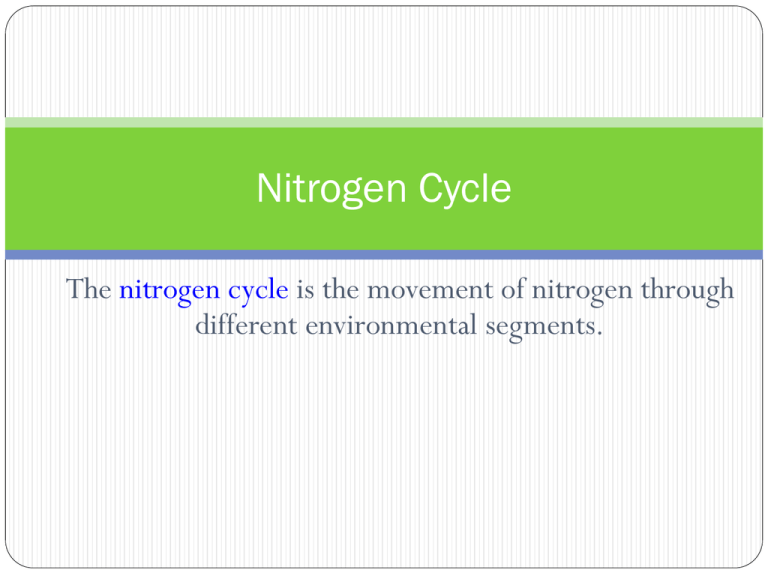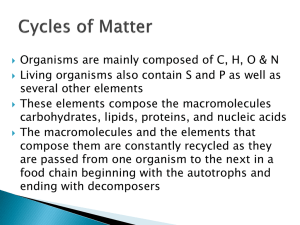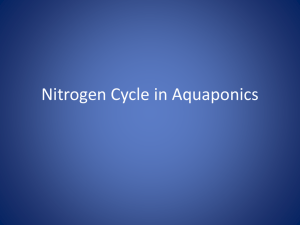Nitrogen-Cycle
advertisement

Nitrogen Cycle The nitrogen cycle is the movement of nitrogen through different environmental segments. Nitrogen Nitrogen is essential for life. It is found in amino acids, proteins, and genetic material. Nitrogen in our environment Nitrogen is the most abundant element in the atmosphere (~78%). However, gaseous nitrogen must be 'fixed' into another form so that it can be used by living organisms. Forms of Nitrogen useable for plants Urea CO(NH2)2 Ammonia NH3 (gaseous) Ammonium NH4 Nitrate NO3 Nitrite NO2 Nitrogen Fixation Nitrogen fixation means making atmospheric nitrogen (N2) available for plant consumption through ammonia and nitrates. Nitrogen fixation occurs naturally in the following ways. Lightening Biological fixation I. II. Ammonificaiton Nitrification Fixation by Lightning The energy from lightning causes nitrogen (N2) and water (H2O) to combine to form ammonia (NH3) and nitrates (NO3). Precipitation carries the ammonia and nitrates to the ground, where they can be assimilated by plants. Biological Fixation About 90% of nitrogen fixation is done by bacteria. Cyanobacteria convert nitrogen into ammonia and ammonium. N2 + 3H2 → 2NH3 Ammonia can be used by plants directly. Ammonia and ammonium may be further reacted in the nitrification process. Ammonification When plants and animals die, bacteria convert nitrogen nutrients back into ammonium salts and ammonia. This conversion process is called ammonification. Amino acids + 11/2O2 CO2 + H2O + NH3 + 736kJ This process liberates a lot of energy which can be used by the Saprotrophic microbes Nitrification Nitrification occurs by the following reactions: 2 NH3 + 3 O2 → 2 NO2 + 2 H+ + 2 H2O 2 NO2- + O2 → 2 NO3 Aerobic bacteria use oxygen to convert ammonia and ammonium. Nitrosomonas bacteria convert nitrogen into nitrite (NO2-) and then nitrobacter convert nitrite to nitrate (NO3-). The nitrogen fixers Cyanobacteria are nitrogen fixers that also fix carbon (these are photosynthetic) Rhizobium bacteria are mutualistic with certain plant species e.g. Legumes They grow in root nodules Azotobacter are bacteria associated with the rooting zone (the rhizosphere) of plants in grasslands Nitrogen fixation by bacteria Atmospheric nitrogen is chemically fixed by bacteria to ammonium (NH4+1) , which is used by plants as a fertilizer. Some bacteria exist in a symbiotic relationship with plants (legumes and some root-nodule species). Plants utilize the nitrate as a nutrient. Animals obtain nitrogen by eating plants or plant-eating animals. Only prokaryotes show nitrogen fixation These organisms possess the nif gene complex which make the proteins, such as nitrogenase enzyme, used in nitrogen fixation Nitrogenase is a metalloprotein, protein subunits being combined with an iron, sulphur and molybdenum complex The reaction involves splitting nitrogen gas molecules and adding hydrogen to make ammonia N2 2N - 669 kJ 2N + 8H+ NH3 + H2 + 54 kJ This is extremely energy expensive requiring 16 ATP molecules for each nitrogen molecule fixed The microbes that can fix nitrogen need a good supply of energy Nitrification This involves two oxidation processes The ammonia produced by ammonification is an energy rich substrate for Nitrosomas bacteria They oxidise it to nitrite: NH3 + 11/2O2 NO2- + H2O + 276kJ This in turn provides a substrate for Nitrobacter bacteria oxidise the nitrite to nitrate: NO3- + 1/2O2 NO3- + 73 kJ This energy is the only source of energy for these prokaryotes so they are called chemoautotrophs. Return to the atmosphere: Denitrification Nitrates and nitrites can be used a source of oxygen for Pseudomonas bacteria Favourable conditions: Cold waterlogged (anaerobic) soils 2NO3- 3O2 + N2 2NO2- 2O2 + N2 providing up to 2385kJ The liberated oxygen is used as an electron acceptor in the processes that oxidise organic molecules, such as glucose These microbes are, therefore, heterotrophs Industrial N-Fixation The Haber-Bosch Process N2 + 3H2 2NH3 - 92kJ The Haber process uses an iron catalyst High temperatures (500°C) High pressures (250 atmospheres) The energy required comes from burning fossil fuels (coal, gas or oil) Hydrogen is produced from natural gas (methane) or other hydrocarbon Nitrogen Cycle Atmospheric Pollution The exhaust emissions of cars contribute a lot to atmospheric pollution in the form of NOx These compounds form photochemical smogs They are green house gases They dissolve in rain to contribute to acid rain in the form of nitric acid The rain falling on soil and running into rivers They contribute to the Eutrophication of water bodies How to make things better? The need for synthetic fertilisers can be reduced by cultural practices Avoiding the use of soluble fertilisers in sandy (free draining soil) prevents leaching Rotating crops permits the soil to recover from nitrogen hungry crops (e.g. wheat) Adding a nitrogen fixing crop into the rotation cycle Ploughing aerates the soil and reduces denitrification Draining water logged soil also helps reduce denitrification








